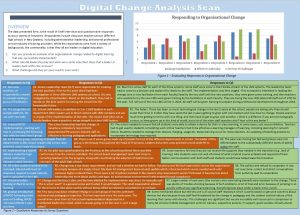Our team, Awesome Sauce, is exploring educational Apps, and looking more specifically at edX, which is a MOOC that features an accompanying app for mobile learning. I have decided to look at universal design for learning (UDL) in particular, and will be logging my experience through this blog to help me gather thoughts and drive what will ultimately result in a critically reflective paper.
In my learning plan, I stated that I would be rooting my analysis in relevant literature, and to begin I wanted to look at research into UDL that was not specifically tied to MOOCs or apps. Essentially I wanted to know what the research about UDL had to say about learning in general. An important note about what UDL is not: it is not designed specifically for people with disabilities, rather it is a framework to make learning as universally accessible to the most number of users possible, and has its roots in similar concepts in architecture (Rose & Meyer, 2007). Edyburn (2005) notes that UDL is driven by three core components:
- Multiple means of representation to give learners various ways of acquiring information and knowledge
- Multiple means of expression to provide learners alternatives for demonstrating what they know,
- Multiple means of engagement to tap into learners’ interests, challenge them appropriately, and motivate them to learn.
In the growth and adoption of UDL, digital technology is an essential element. Digital technology offers learners choice as far as representation goes. I am curious to know the extent to which UDL is an applicable framework for a platform like a MOOC offered through an educational app.
Before I can do this, I need to have a firmer grasp on what UDL is in a broader sense, and if I can find literature that addresses UDL and mobile learning platforms, I hope to be better able to critique the offerings of the MOOCs offered through the edX app.
References
Edyburn, D. (2005). Universal Design for Learning. Special Education Technology Practice, 7(5), 16-22. Retrieved from http://citeseerx.ist.psu.edu/viewdoc/download?doi=10.1.1.552.9700&rep=rep1&type=pdf
Rose, D., & Meyer, A. (2007, October). Teaching Every Student in the Digital Age: Universal Design for Learning. Educational Technology Research and Development, 55(5), 521-525. doi:https://doi-org.ezproxy.royalroads.ca/10.1007/s11423-007-9056-3


 In secondary education these days there is a big push to incorporate educational technology in the classroom. Economic reality dictates creative solution for any school managing this, particularly large schools catering to more than 1000 students. Operating budgets cannot keep up with the cost and rapid change of devices required for classroom use. Smaller schools have been able to manage this change better, when the school board that serves the pieces of operational pie capital is adequately managed and funded. To deal with spiralling operating overhead, operating costs get outsourced to parents who now are expected to purchase devices for their children in the same way they are expected to purchase stationery (the politics of this can be discussed on Facebook or Twitter as it will detract from the purpose of this post!)
In secondary education these days there is a big push to incorporate educational technology in the classroom. Economic reality dictates creative solution for any school managing this, particularly large schools catering to more than 1000 students. Operating budgets cannot keep up with the cost and rapid change of devices required for classroom use. Smaller schools have been able to manage this change better, when the school board that serves the pieces of operational pie capital is adequately managed and funded. To deal with spiralling operating overhead, operating costs get outsourced to parents who now are expected to purchase devices for their children in the same way they are expected to purchase stationery (the politics of this can be discussed on Facebook or Twitter as it will detract from the purpose of this post!)
 The digital age is changing the way life is conducted. We learn differently. We access information differently. We work differently. We exist, differently. All of these realities, and we are still changing, so, how to manage this? Are we hanging on to the organisational structurees of work-life-education as a last vestige, a sentinel against the great digital unknown? The various mediums for life in the 21st century are constantly moving forward like a Space X rocket, but we are in many ways being guided through this journey by a gasoline powered engine because it is familiar. The rocket will carry us into unknown and potentially dnagerous new realms, but what marvels we will experience on the journey! The trusty old engine will get us somewhere reliable familiar and safe, but we will never reach the depths of untapped potential of the rocket. This is the challenge of managing and leading in the digital age.
The digital age is changing the way life is conducted. We learn differently. We access information differently. We work differently. We exist, differently. All of these realities, and we are still changing, so, how to manage this? Are we hanging on to the organisational structurees of work-life-education as a last vestige, a sentinel against the great digital unknown? The various mediums for life in the 21st century are constantly moving forward like a Space X rocket, but we are in many ways being guided through this journey by a gasoline powered engine because it is familiar. The rocket will carry us into unknown and potentially dnagerous new realms, but what marvels we will experience on the journey! The trusty old engine will get us somewhere reliable familiar and safe, but we will never reach the depths of untapped potential of the rocket. This is the challenge of managing and leading in the digital age. 
